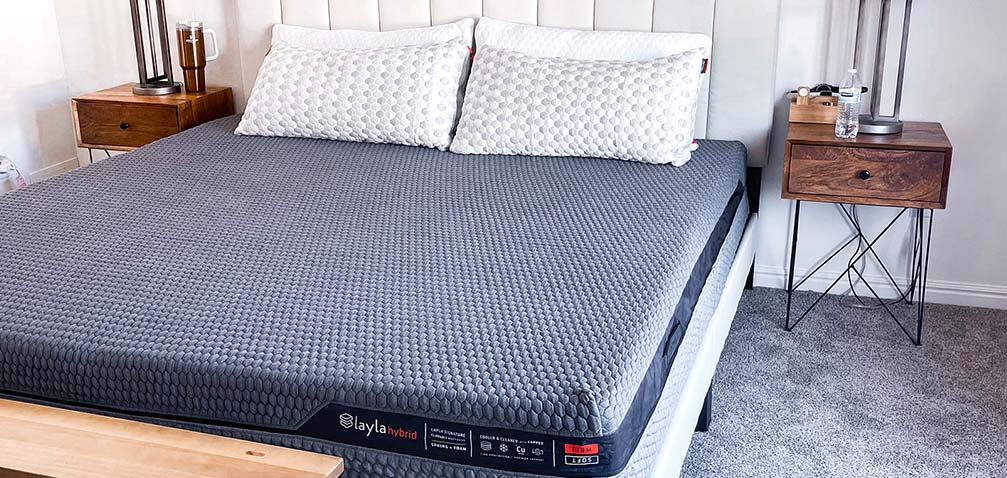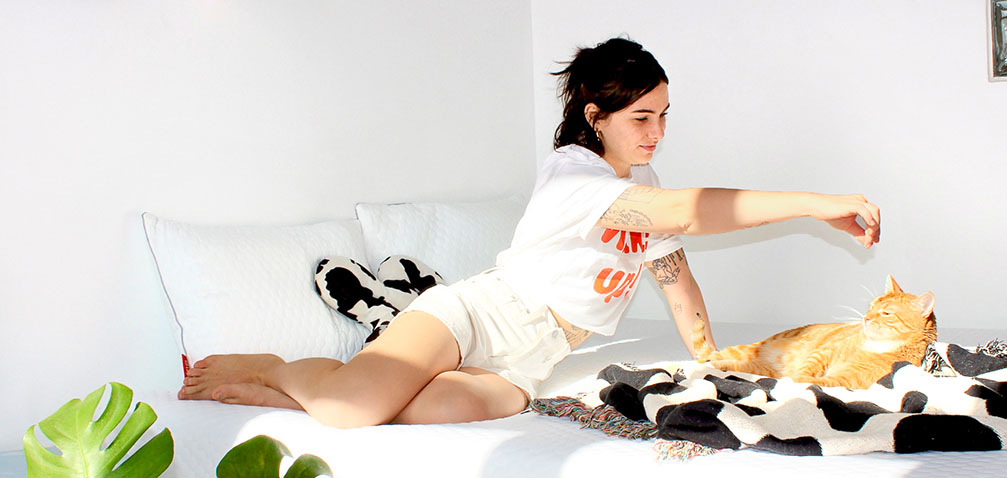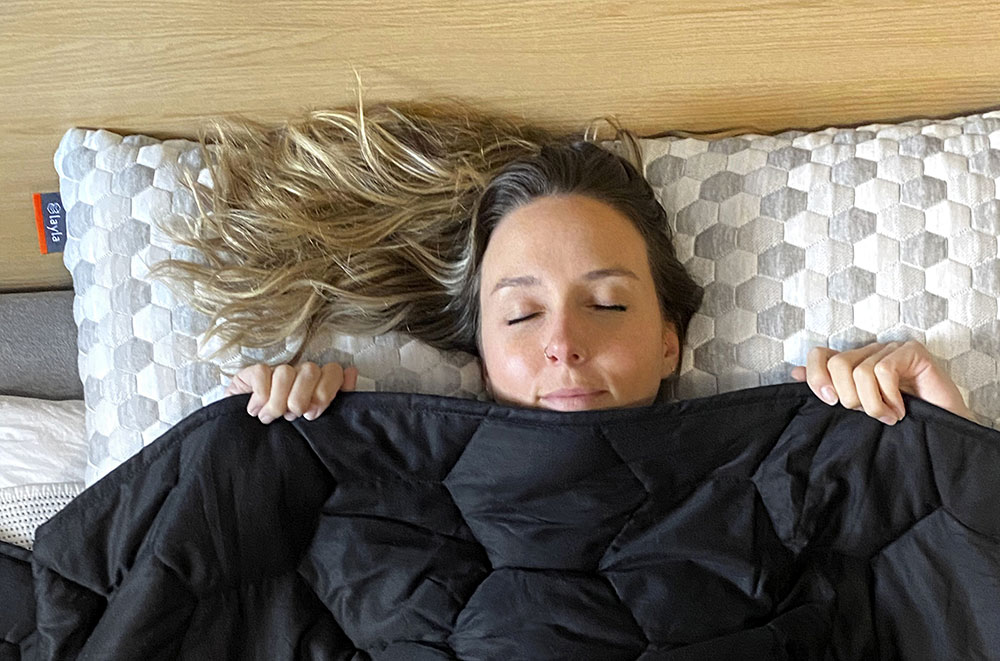However, certain colors are commonly associated with relaxation and tranquility, making them popular choices for creating a sleep-promoting bedroom. Let’s explore a few of the best paint colors for bedrooms and how they can promote relaxation.
- 1. Blue
- 2. Green
- 3. Yellow
- 4. White
- 5. Pink
- 6. Beige
- 7. Pastels
- What Are the Worst Bedroom Colors for Sleep?
- Additional Tips for Creating a Sleep-Friendly Bedroom
- Wrapping Up: Best Bedroom Paint Colors for Sleep
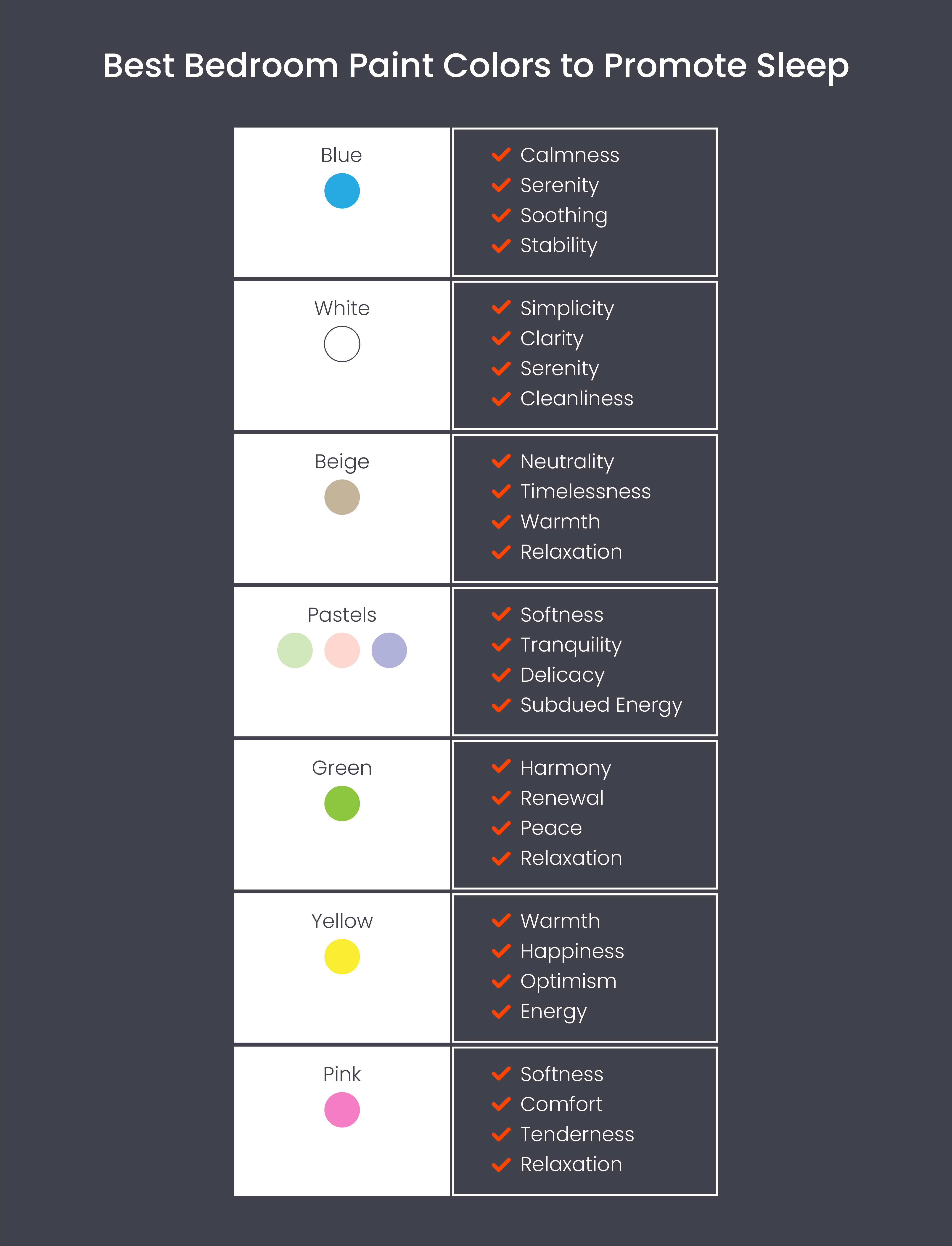
1. Blue
Blue of any shade is one of the best colors for promoting sleep. According to color psychology, blue has calming and soothing properties. It’s also associated with relaxing images and places, such as the ocean or sky, which can support your sleep cycles.
Sleep Junkie, a website that provides data and tips to help people get a better night’s sleep, recently surveyed over 1,000 people about bedroom paint colors, configurations, and other elements to determine how their choices affected their sleep. While this is a relatively small sample size, this study revealed that 76% of respondents slept well in bedrooms painted blue.
This research supports older data from Travelodge in 2013, which found that blue is the best bedroom color for sleep. In addition, a more recent 2022 study from The University of Sussex found that blue is the most relaxing color in the world.
2. Green
Green is another color that promotes relaxation. According to a study on Interior Color and Psychological Functioning in a University Residence Hall, green paint colors for bedrooms were the second best color for promoting sleep in men and women after blue.
The color green is often associated with nature, freshness, and relaxation, which can contribute to a calmer bedroom atmosphere. In addition, research suggests that green environments can have a positive impact on reducing stress and anxiety levels, promoting feelings of tranquility, balance, and rejuvenation.
3. Yellow
According to the Travelodge study from 2013, yellow was the second best bedroom color for sleeping, with individuals sleeping in a yellow bedroom getting an average of 7 hours and 40 minutes of sleep a night. Of course, this is for certain shades of yellow only. A bright shade of yellow can have the opposite effect.
The results were similar to the Sleep Junkie survey in which 67% of respondents typically slept well in a yellow environment.
4. White
The color white is commonly associated with cleanliness and simplicity, which can create a sense of serenity in a bedroom while reducing visual distractions and promoting relaxation. White also reflects light, making rooms feel larger.
The Sleep Junkie survey found that white was the third-best paint color for sleep. The same survey found that 46% of men and 37% of women respondents had white walls.
5. Pink
Pink is another color associated with relaxation and emotional calmness. As with yellow, we’re talking about light pink or pastel pink, not hot pink, which can have the opposite effect.
However, certain shades of pink can have a calming effect on the mind and body. It’s associated with feelings of comfort that can help create a peaceful and gentle atmosphere in the bedroom, helping to reduce anxiety and muscle tension while producing a calming effect.
6. Beige
Beige is another color that can help create a sense of balance and tranquility to promote sleep. Beige is a light shade of brown that can have a calming effect to promote relaxation to prepare the mind and body for sleep. It also represents timelessness and simplicity, bringing warmth to any room to create a cozy environment.
However, it’s important to ensure you choose a true shade of beige, as research has found that brown and dark brown are some of the worst colors for sleep. Erring on the lighter, calmer shade of brown that’s close to beige and tan can help ensure you create a peaceful sleeping environment.
7. Pastels
Lighter tones may also affect sleep quality. Muted shades are typically better for sleep than vibrant ones. They’re more sleep-friendly than reds, oranges, and neons, which tend to be more energizing and can interfere with relaxation.
On the other hand, pastels create a more calming and serene atmosphere that promotes relaxation. By painting your bedroom pastel colors, such as mauve, mint green, periwinkle, and peach, you can create a more soothing ambiance to promote better sleep and peacefulness.
What Are the Worst Bedroom Colors for Sleep?
The impact of color on sleep and human emotions is an ongoing area of research. While there is anecdotal evidence and some studies exploring the effects of color on mood and relaxation, it is important to acknowledge that individual responses to color can vary.
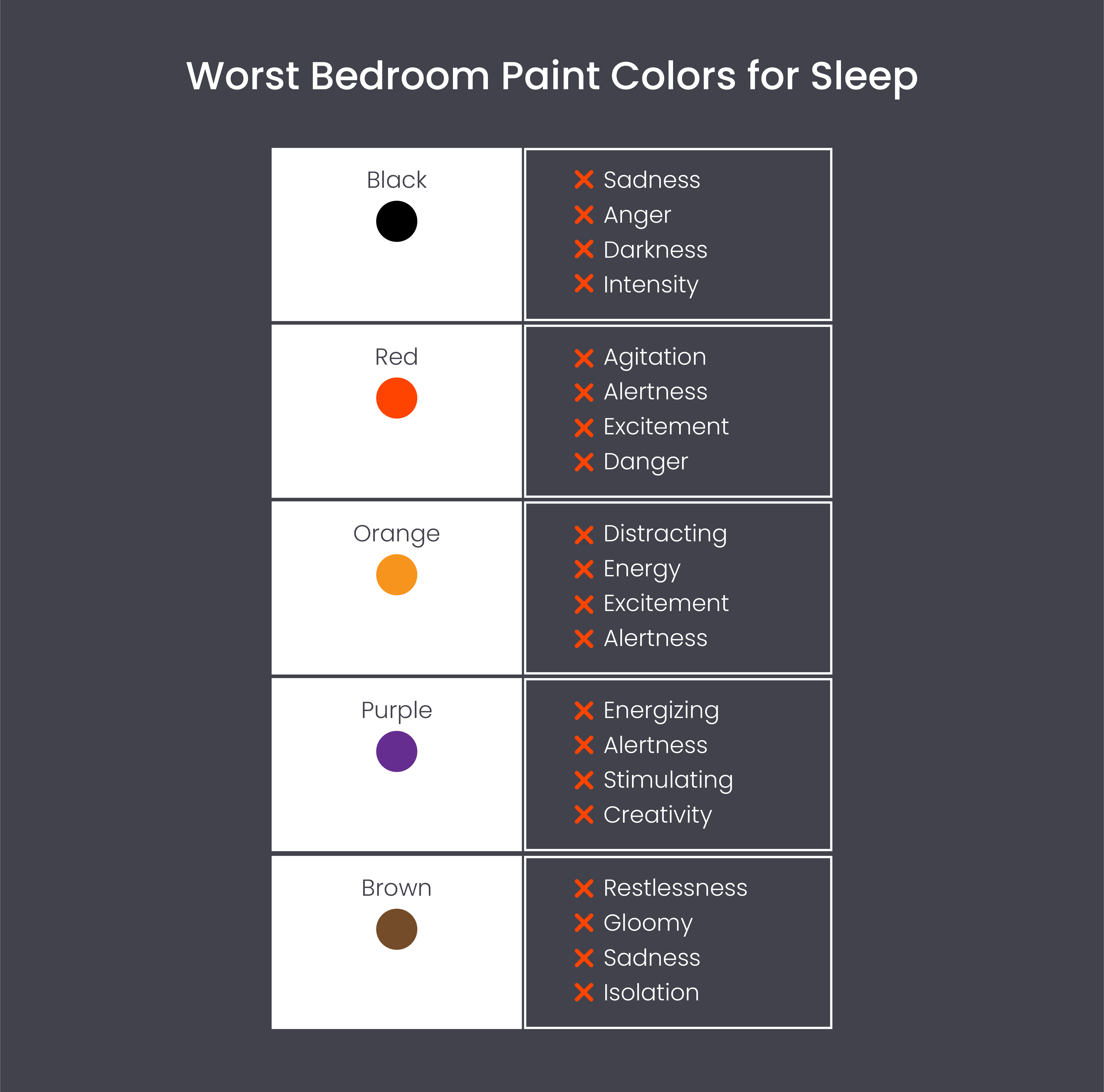
In general, a few of the worst bedroom colors for sleep are:
- Black: You might think dark colors can promote better sleep because dark environments are better for sleep. However, black walls can make a room feel much smaller and heavier. It can also make you feel less well-rested in the morning because it absorbs light rather than reflecting it, leading to sleep inertia or grogginess after waking up.
- Red: Red is a stimulating color that can make it difficult to fall asleep. Because it’s vibrant, it can evoke feelings of alertness, agitation, and excitement. In addition, studies have found that red increases blood pressure, which can prevent a restful night’s sleep and lead to excessive daytime sleepiness.
- Orange: Similar to red, orange can also evoke similar feelings of excitement and energy, as the vibrancy of orange can hinder the relaxation needed to promote sleep, which can lead to sleep deprivation.
- Purple: The Travelodge study found that individuals sleeping in a purple room only get 5 hours and 6 minutes of sleep per night. Purple can be stimulating, as a variety of purple hues have red undertones that can increase energy levels and alertness. However, soft, muted purples like lavender can have a calming effect that can promote sleep.
- Neon Colors: Neon colors are associated with energy and vibrancy, keeping the mind in an alert state. In addition, neon colors may trick your brain into thinking it’s morning, suppressing the production of melatonin and ultimately affecting your body’s ability to regulate sleep.
Additional Tips for Creating a Sleep-Friendly Bedroom
Color isn’t the only element of your bedroom that can dramatically impact your sleep quality. Incorporate these elements into your bedroom to enhance relaxation, reduce distractions, and create a more peaceful atmosphere to improve your sleep:
- Invest in the right mattress: A comfortable mattress can drastically improve your sleep quality by supporting your head, neck, and spine while relieving pressure and providing overall comfort. Choose a memory foam or hybrid mattress based on your preferences and sleep position.
- Use quality bedding: Being too hot or cold can affect your ability to fall asleep and stay asleep. However, you can regulate your body temperature by choosing the right bedding for the time of year. Quality bedding made from soft, breathable materials can promote better sleep and enhance your overall experience while keeping you cool or warm, preventing you from waking up at night. Choose thicker materials like flannel during the winter and breathable materials like bamboo sheets and cotton during the summer.
- Promote organization and cleanliness: A clean, clutter-free environment promotes relaxation. You should keep your entire room, from the floor to the ceiling, free of dust and clutter that can cause visual distractions or health problems like allergies that can affect your sleep.
- Choose the right lighting: Bright light can suppress melatonin, making your body and mind believe it’s still daytime. Use warm, dim lighting in your bedroom to signal that it’s time to wind down. If street lights flood through your window at night, consider using blackout shades to block any light that can disrupt your sleep. You can also use a sleep mask.
- Add plants and greenery: Adding plants and greenery can make the environment more relaxing. Not only does the color green remind us of nature, but plants can purify the air and reduce allergens that disrupt your sleep.
- Eliminate noise: Noise can startle you awake in the middle of the night or delay sleep, affecting your ability to fall asleep and stay asleep. If you live in a loud area with lots of noise pollution, you can use white noise to sleep by blocking out all other sounds.
Wrapping Up: Best Bedroom Paint Colors for Sleep
The impact of color on sleep is still being explored. While research is currently limited, the choice of bedroom color may impact your sleep quality and overall experience in the room. Sticking to lighter shades can promote calmness, while vibrant shades can be more stimulating, making you feel more energized and alert.
In addition, creating a sleep-friendly environment goes beyond wall colors and includes factors like bedding, lighting, and cleanliness. Improve your sleep quality with Layla. We offer a range of mattresses, pillows, and bedding designed to improve comfort and support to improve your sleep.
Shop our collection of sleep-enhancing products today.

